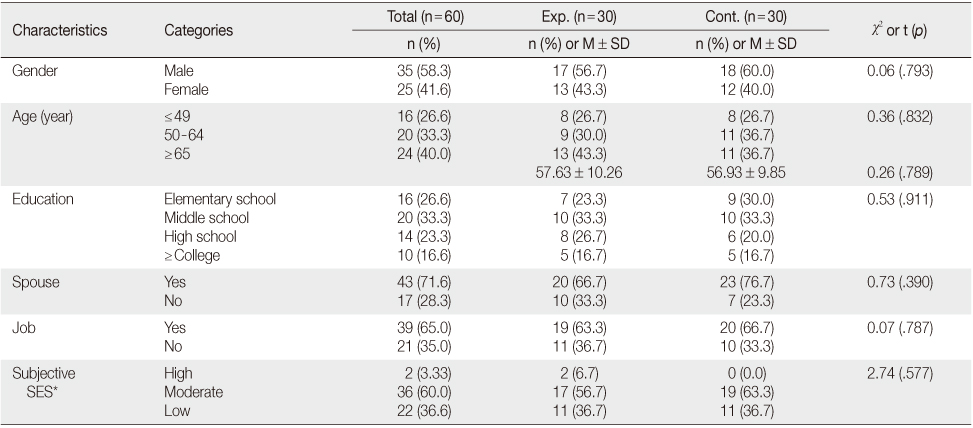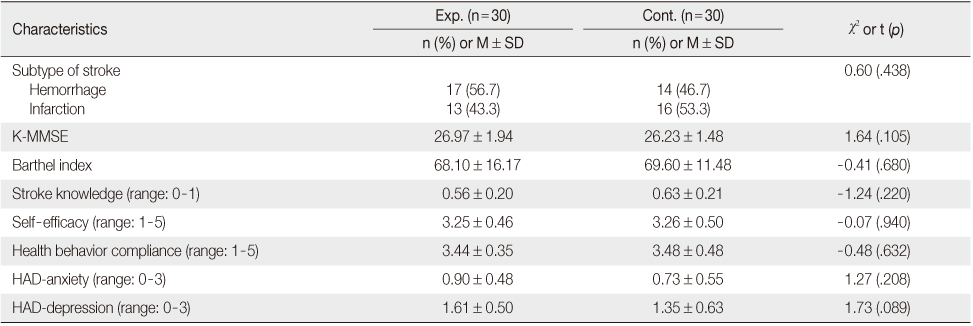Articles
- Page Path
- HOME > J Korean Acad Nurs > Volume 44(5); 2014 > Article
-
Original Article
- Effectiveness of a Self-management Program using Goal Setting based on a G-AP for Patients after a Stroke
- Min Gyeong Park, Yeongmi Ha
-
Journal of Korean Academy of Nursing 2014;44(5):581-591.
DOI: https://doi.org/10.4040/jkan.2014.44.5.581
Published online: October 31, 2014
1Yeson Rehabilitation Medicine Hospital, Jinju, Korea.
2College of Nursing·Institute of Health Sciences, Gyeongsang National University, Jinju, Korea.
- Address reprint requests to: Ha, Yeongmi. College of Nursing & Institute of Health Sciences, Gyeongsang National University, 816-15 beon-gil Jinju-daero, Jinju 660-987, Korea. Tel: +82-55-772-8253, Fax: +82-55-772-8222, yha@gnu.ac.kr
© 2014 Korean Society of Nursing Science
This is an Open Access article distributed under the terms of the Creative Commons Attribution NoDerivs License. (http://creativecommons.org/licenses/by-nd/4.0/) If the original work is properly cited and retained without any modification or reproduction, it can be used and re-distributed in any format and medium.
Figure & Data
REFERENCES
Citations

- Study Protocol for a Hospital-to-Home Transitional Care for Older Adults Hospitalized with Chronic Obstructive Pulmonary Disease in South Korea: A Randomized Controlled Trial
Heui-Sug Jo, Woo-Jin Kim, Yukyung Park, Yu-Seong Hwang, Seon-Sook Han, Yeon-Jeong Heo, Dahye Moon, Su-Kyoung Kim, Chang-Youl Lee
International Journal of Environmental Research and Public Health.2023; 20(15): 6507. CrossRef - Predictive Model of Self-management in Patients With Stroke Based on the Information-Motivation-Behavioral Skills Model
Sung Reul Kim, Sunho Kim, Hye Young Kim, Kyung-Hee Cho
Journal of Cardiovascular Nursing.2023; 38(2): 158. CrossRef - Factors Influencing Health Behavior Compliance in Adult Moyamoya Patients
Bo Eun Kim, Ju-Eun Song
Journal of Korean Academy of Nursing.2021; 51(1): 80. CrossRef - The Effect of a Movie-Based Nursing Intervention Program on Rehabilitation Motivation and Depression in Stroke Patients
Hye Kyung Kwon, Sook Ja Lee
Journal of Korean Academy of Nursing.2017; 47(3): 345. CrossRef - Comparison of Motivation for Rehabilitation, Family Support and Adherence to Rehabilitation between Depressive and Non-depressive Stroke Patients
An Suk Park, Eun Ko, Hee Sun Kang
The Korean Journal of Rehabilitation Nursing.2016; 19(2): 138. CrossRef - Influence of Uncertainty, Physiologic Risk Factors, Self-efficacy on Self-management in Stroke Patients
Sook Hee Cho, Kyung Soon Yun
Journal of muscle and joint health.2016; 23(2): 114. CrossRef - Effectiveness of a Stroke Risk Self-Management Intervention for Adults with Prehypertension
Hee-Young Song, Kyoung A Nam
Asian Nursing Research.2015; 9(4): 328. CrossRef - Factors related to Fear of Recurrence in Stroke Patients*
Ji won Chung, Jung-Hee Kim
Journal of Korean Academy of Fundamentals of Nursing.2015; 22(2): 190. CrossRef
Self-management Program using Goal Setting based on a G-AP for Patients after a Stroke
G-AP=Goal setting and Action Planning framework.
Test of General Characteristics in Patients after a Stroke (N=60)
*Fisher's exact test; Exp.=Experimental group; Cont.=Control group; SES=socioeconomic status.
Homogeneity Test of Disease-related Characteristics in Patients after a Stroke (N=60)
Exp.=Experimental group; Cont.=Control group; K-MMSE=Korea Mini Mental State Examination; HAD=Hospital anxiety and depression.
Effectiveness of a Self-management Program Using Goal Setting based on a G-AP (N=60)
Exp.=Experimental group; Cont.=Control group; HAD=Hospital Anxiety and Depression; G-AP=Goal setting and Action Planning framework.
G-AP=Goal setting and Action Planning framework.
*Fisher's exact test; Exp.=Experimental group; Cont.=Control group; SES=socioeconomic status.
Exp.=Experimental group; Cont.=Control group; K-MMSE=Korea Mini Mental State Examination; HAD=Hospital anxiety and depression.
Exp.=Experimental group; Cont.=Control group; HAD=Hospital Anxiety and Depression; G-AP=Goal setting and Action Planning framework.
 KSNS
KSNS
 E-SUBMISSION
E-SUBMISSION




 Cite
Cite

